#CWDM Mux and DeMux Module
Explore tagged Tumblr posts
Video
youtube
18CH CWDM DWDM Mux/Demux Module manufactured by SOPO #CWDM #dwdm #wdm ...
0 notes
Photo

www.10giga.com.cn,45M homes passed with pre-connectorized #FTTHSolution using #Corning #Fiber,But,at #SoarTelecom factory plant,#CWDM,#MPO,#MTP,#DWDM,#PatchCable,#ADSS,#OutdoorCableproduct assembling,You know what, #Corning,Our Core #BareFiber Material supplying ,Stop by asking more about business purposing,contact freely #Cell,(86)13692286535
0 notes
Text
Uses for an optical isolator

Rotators Difference between an Optical Circulator & Isolator & RotatorĪn optical circulator is used to route the incoming light signals from port 1 to port 2 in a way that if some of the emitted light is reflected back to the circulator, it doesn’t exit from port 1 but from port 3. This rotator is used for amplitude modulation of light and is an integral part of optical isolators and optical circulators. What is an optical rotator?Īn optical rotator is typically an in-line Faraday rotator that is designed to rotate the polarization of the input light by 45 degrees. This is what makes it possible to achieve higher isolation. Hence, it adds to the total of 90 degrees when light travels in the forward direction and then the same in the backward direction. It happens because of the change in the relative magnetic field direction, positive one way, and negative the other way. It means that the rotation is positive 45 degrees in the forward direction and negative 45 degrees in the reverse direction. The polarization rotation caused by the Faraday rotator always remains in the same relative direction. Its main component is the Faraday rotator which ensures non-reciprocal rotation while maintaining linear polarization. What is an optical isolator?Īlso known as an optical diode, an optical isolator is an optical passive component that allows the light to travel in only one direction. While some circulators are three-port devices, there are also four-port circulators. In short, it is designed such that the light coming from one port exits from the next port. What is an optical circulator?Īn optical circulator is a high-performance light-wave component that is designed to route the incoming light signals from Port 1 to Port 2 and the incoming light signals from Port 2 to Port 3. Circulator & Isolator & RotatorĪs we are discussing specifically optical passive components, you will learn here about optical circulators, optical isolators, and optical rotators rather than their electronic counterparts. So, if you are curious to know about these little yet important optical passive components, read the blog till the end. We will first talk about what these components exactly are and then share what makes them different from each other. Today, we will discuss three different optical passive components, namely circulator & isolator & rotator. What is a polarization maintaining filter coupler?.A Concise Selection Guide for In-Line Polarizers.What is the importance of 80um PM fiber components?.The Growing Demand for PM Fiber Components in 2023 and Beyond.Why Should Polarization Maintaining Filter Coupler Feature High Extinction Ratio?.Polarizing Beam combiners/splitters (2).High Power Faraday Rotator and Isolator (1).(6+1)X1 Pump and Signal Combiner 2+1X1 Pump Combiner 8CH CWDM Module 16CH CWDM Module 19" rack mount chassis CWDM 1060nm Cladding Power Stripper 1064nm Band-pass Filter 1064nm Components 1064nm Fiber Collimator 1064nm High Power Isolator ABS plastic box Cladding Power Stripper Collimator Compact CWDM Module CWDM CWDM Multiplexer CWDM Mux/Demux CWDM MUX/DEMUX Module DWDM DWDM Multiplexer fiber optica connector fiber optic coupler FTTX Fused Coupler fused wdm FWDM High Power Fused Coupler High power isolator Isolator LGX CWDM Module Mini Size CWDM Mini Size Fused WDM Multimode High Power Isolator OADM optical circulator optical coupler Optical fiber communication optical isolator PLC Splitter pm circulator PM Components pm isolator pump combiner Pump Laser Protector WDM DK Categories

0 notes
Text
arkoptics.com
A passive multiplexer in most networks consists of a mux and demux optical component. The mux combines, or multiplexes, wavelengths onto a fiber. The demux on the other end of the connection splits, or de-multiplexes, the connections.
In DWDM system, DWDM mux demux is two indispensable modules. Mux (Multiplexer) is a module at the transmitter end that brings several data signals together for transporting over a single fiber, while Demux (Demultiplexer) is a module at the receiver end that separates the signals that come together and passes each channel to an optical receiver.
CWDM mux demux (Coarse Wavelength Division Multiplexer/Demultiplexer) is a flexible, low-cost solution that enables the expansion of existing fiber capacity. CWDM multiplexer is for combining signals together, while demultiplexer is for splitting signals apart.
A polarization-maintaining (PM) WDM filter is a small device used to multiplex PM signals while maintaining the output polarization. When you are using highly efficient systems, PM fibers and PM signals play a very critical role in ensuring the desired efficiency.
Fiber Patch Cord & Cable Assembly, often called fiber patch cable, fiber jumper, or fiber patch lead, is a length of fiber cable that terminated with fiber optic connectors (LC, SC, MTRJ, ST and etc.) at each end. The connectors allow fiber optic patch cord to be rapidly connected to an optical switch or other telecommunications/computer device.
Fiber loopback is widely used for various applications. In terms of telecommunication, loopback is a hardware or software method to feed a received signal or data back to the sender. It is very useful for solving physical connection problems.
Fiber terminators(Plug-in type or Build-out type) are used to terminate unused fiber connector ports in fiber optic systems so optical terminators unwanted reflections are not introduced back into the system. It is used in the fiber-optic networks to install on possibly unused ports.
Fiber optic isolator is a passive component used for fiber optic communications. As a magneto-optic device, the purpose of optical isolator is to allow light to be transmitted in only one direction. An optical isolator is a device that is designed to allow the optical signal travel in the forward direction while block reflections that would travel in the backward direction. Optical isolators are critically important in many applications in optical systems.
FBT splitter(fused biconical taper) is the traditional technology in which two fibers are placed closely together, typically twisted around each other and fused together by applying heat while the assembly is being elongated and tapered. A signal source controls the desired coupling ratio. The fused fibers are protected by a glass substrate and then protected by a stainless steel tube, typically 3 mm diameter by 54 mm long. FBT splitters are widely accepted and used in passive optical networks.
The PLC splitters are used to separate or combine optical signals. A PLC (planar lightwave circuit) is a micro-optical component based on planar lightwave circuit technology and provides a low-cost light distribution solution with small form factor and high reliability. PLCs are manufactured using silica glass waveguide circuits that are aligned with a v-groove fiber array chip that uses ribbon fiber. Once everything is aligned and bonded, it is then packaged inside a miniature housing. PLC splitters have high quality performance, such as low insertion loss, low PDL, high return loss, etc.
1 note
·
View note
Text
WDMs
https://www.china-tscom.com/products/wdm/

T&S has a profound optical process foundation on passive WDM devices; it has unique process technology in optical coating, optical element polishing, optical coupling and optical parameter testing, and is equipped with advanced automatic optical coupling and testing platforms. Provide highly reliable WDM series of products.
TFF Type WDM
T&S TFF WDM is based on Thin Film Filter (TFF) technology. Our Filter-Based WDM product family covers following wavelength windows commonly used in optical fiber systems: 1310/1490/1550nm (for FWDM Device), 1271~1611nm (for CWDM Device or Module), 1525~1565nm (C_band for 100G/200G DWDM Device or Module) and 1269.23~1318.35nm (for 800G LWDM Device or Module), 1271±3.5~1371±3.5nm (for MWDM Device or Module) and 1270/1310/1490/1534/1577/1610/1650nm (for Cex-wdm Modules, including GPON, XG-PON, NG-PON2 and OTDR )
PLC Type WDM
Instead of taking a thin film filter to mux or demux wavelengths, PLC type achieves the same goal by using chip PLC, which uniformly divides and guides light with different wavelengths. At T&S, we currently provide multi-channel AWG DWDM Modules and 4ch CWDM/LWDM Devices.
1525~1565nm (C_band for 100G multi-channel AWG Module) and 1271~1331nm&1295.56~1309.14nm(for PLC CWDM4&LWDM4 Devices, it used for 4x10 Gbps CWDM TOSA&ROSA for QSFP+ or 4X25 Gbps LAN-WDM TOSA&ROSA for QSFP+
0 notes
Text
5G Fronthaul Semi-Active WDM System
https://www.optical-sintai.com/products/5g-fronthaul-semi-active-wdm-system.html
The 5G fronthaul transmission semi-active WDM system launched by Guangzhou Sintai Communication Co., Ltd. is mainly used to solve the problem of lack of optical cable resources for optical fiber remote transmission between DU-AAU in C-RAN architecture.
The scheme features active WDM on the DU side and passive WDM on the AAU side. Through the intervention of active equipment, the management and protection functions of the frontal transmission carrying network are realized.
At the same time, the simple and low-cost characteristics of remote passive are taken into account. The network reliability is improved, and the manageability and maintainability of the fronthaul transmission network are also improved.
5G Fronthaul Semi-Active WDM Sytem Feature
l Support CPRI 1~10 and eCPRI (10G/25G), compatible with STM-1/4/16/64, GE/10GE/25GE, and another multi-service unified bearing, transparent transmission, and maximize the value of frontal transmission network.
l Modular configuration, 1:6/12/18 optional, can achieve multi-directional multi-level convergence, and large-scale optical fiber saving.
l It can provide a variety of color optical modules, support CWDM 18 waves, MWDM 12 waves, meet the requirements of various line power budgets.
l Support optical layer 1:1 protection with protection switching time less than 50ms, improve network reliability.
l Support graphical interface network management, reconstruct wireless and transmission management domain and realize full monitoring of optical module and line status.
l The central office ends active WDM equipment supports AC 220 V and DC-48 V power supply options and 1 + 1 power input protection. Power failure of the equipment will not affect the service transmission.
l Remote passive WDM has outdoor deployment capability and flexible deployment location.
5G Fronthaul Semi-Active WDM Sytem specification
Item of Mux-Demux
CWDM
MWDM
Channel Number
6
12
18
6
12
Central wavelength (nm)
1271~1371
1271~1491,
1271~1371
&1471~1571
1271~1611
1267.5~1314.5
1267.5~1374.5
Pair channel insertion loss (dB)
(Without protection) A
≤3.0
≤4.0
≤4.4
≤3.0
≤4.0
Center wavelength deviation (nm)
±1.5
±1.0
1dB channel bandwidth (nm)
≥13
≥5
The flatness of passband (dB)
≤0.5
Isolation of adjacent channels (dB)
≥30
Isolation of non-adjacent channels (dB)
≥40
Wavelength thermal stability (nm)
≤0.005
Insertion loss thermal stability (dB)
≤0.007
Polarization-dependent loss (dB)
≤0.15
Return loss (dB)
≥40
Protection switching time
<50ms
Working temperature (°C)
0~+70
Storage temperature (°C)
-40 ~+85

0 notes
Photo

HYC offers a full range of CWDM Mux/Demux modules to suit all kinds of applications and network solutions. http://hyc-system.com/Product/index_208/3217
0 notes
Text
How to Realize 100KM DWDM Network With FMT 4000E
Nowadays, DWDM technology has been one of the most commonly used technology in optical transport network (OTN) applications due to the increasing bandwidth need of telecommunication providers. Faced with unpredictable traffic requirements and increasing bandwidth demands, FS has developed a new standardized optical transport solution, which called FMT WDM transport platform. And this FMT WDM transport platform is divided into four specific series according to different transmission distance, including CWDM solution FMT 1800, DWDM solution FMT 1600E, 4000E, 9600E. In this post, we will take FMT 4000E optical transport platform as an example to illustrate how does this transport platform realizes 100km network connections and its advantages.
What Is FMT 4000E DWDM Network Transport Platform?
As mentioned above, FMT 4000E DWDM network transport platform is one type of the FMT WDM transport platform series. This optical transport platform is a 4U managed chassis. It is equipped with 16 full-size slots and optical layer modules and a wide range of intelligent services modules can be installed in these slots. Equipped optical devices in FMT 4000E will be illustrated in detail in the following part.


Currently, FS has developed two versions FMT 4000E, but these two versions has different transmission. One version can support 160km transmission, while another can support 100km transmission. And this post will focus on FMT 4000E for 100km. This platform can achieve 100km end-to-end dual fiber bidirectional transport and support up to 40 wavelengths from C21-C60 at 100GHz. In addition, this optical transport platform can be applied in metro/regional networks, such as CATV, FTTH/PON, xDSL triple play services, GSM/3G mobile services, business customers storage services and so on.

How Does the DWDM Network Work By Using FMT 4000E

From the above topology, we can find that the optical signal from the switch will be sent to 40CH DWDM MUX DEMUX at Site A for wavelength division multiplexing. And then the optical power will be lowered by using optical attenuator. And the dispersion will be compensated by DCM. When this process is finished, the booster amplifier (BA) will improve the optical power and extend the transmission distance. After 100km fiber transmission, we need to amplify the signal by using pre-amplifier (PA) and then the optical signal will be compensated by DCM again. At this time, the optical signal will be sent to 40CH DWDM MUX DEMUX at Site B for demultiplexing again. Finally, the optical signal will be sent to the switch.
Why Choose This FMT 4000E DWDM Transport Platform?
This FMT 4000E DWDM transport platform has flexible networking because it is equipped with intelligent DWDM MUX/DEMUX, integrated with DWDM EDFA and DCF-based DCM system management. This platform has high channel density because it has up to 40 DWDM channels. And this platform can achieve 100km end-to-end dual fiber bidirectional transport when the fiber link loss is 0.25dB/km and the fiber type is G.652D. In addition, this platform has monitor online management software, which can allow operators and administrators to monitor the performance of the whole network. When the urgent accident occurs, this network management system can notify the user so as to ensure the safety of the network. This system can also provide real-time management for local and remote network. Besides, it will send email to inform you of the performance of the network.

Conclusion
This FMT 4000E optical transport platform will be a cost-effective option for l00km transmission due to its better network performance and centralized network management. And FS is always striving for meeting your specific needs and this product is customized for each customer. If you are interested in this product, please contact us via [email protected].
0 notes
Photo

www.10giga.com.cn | #CWDM Multiplexer #MUX/#DEMUX #Modules, Why #CWDM,#DWDM,#CWDM,#MPO,#MTP as cost-effective choosing at mulitservice #Fiber Network,? no doublt,Hurry up for RFQ requested to [email protected]
0 notes
Text
Single Fiber CWDM MUX and DEMUX Tutorial
Understand Single Fiber CWDM MUX and DEMUX
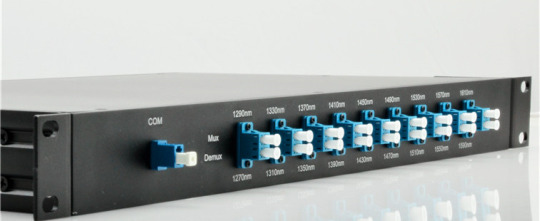
The CWDM technic multiplexes optical signals together on one single fiber. As a universal equipment, it can combine different wavelengths in a CWDM Mux/Demux to achieve this. Coupled with highly reliable passive optics certified for environmentally hardened applications, the CWDM Mux/Demux make operators take full advantage of available fiber bandwidth in local loop and enterprise architectures. CWDM Mux/Demux is a flexible and cost-efficient solution that expand the existing fiber capacity. When there is only one fiber available for network capacity expansion. Then, single fiber CWDM MUX and DEMUX is being used. The single fiber CWDM MUX DEMUX has a simplex line port (shown in the above picture), which is the biggest difference from the bidirectional CWDM MUX DEMUX on the appearance.
Working principle
The single fiber CWDM MUX/DEMUX uses the CWDM wavelengths in a way different from the bidirectional CWDM MUX DEMUX, so it can achieve dual way transmission. Each wavelength in bidirectional CWDM network runs on two opposite directions but just on one direction in single fiber CWDM network. There are two options for you if you want to build a dual way transmission link between two sites. First option is use one wavelength over duplex fiber with dual-fiber CWDM MUX DEMUX, the second option is use two wavelengths (one for TX and the other for RX) over simplex fiber with single fiber CWDM MUX DEMUX.

The picture shown above give us a description of the Use of CWDM Wavelength in Single Fiber CWDM Network. In this network, 16 wavelengths are used to support 8 pairs of dual-way transmission. On site A, there deployed an 8-channel single fiber CWDM MUX DEMUX using 8 wavelengths for transmitting and the other 8 wavelengths for received. On the opposite site B, also a single fiber CWDM MUX and DEMUX is deployed. However, the wavelengths for TX and RX are reversed. For instance, a pair of dual-way signal uses 1270nm for TX and 1290nm for RX on site A, while use 1290nm for TX and 1270nm for RX on site B. This is how the single-fiber CWDM MUX and DEMUX achieving dual-way transmission.
The Ports On CWDM MUX DEMUX
The basic function of the CWDM is to increase the network capacity by combine the data rate of variety wavelengths over the same fiber cable. So the must-have ports for these devices are channel ports supporting different wavelengths or Line port used to connect the WDM MUX/DEMUX.
Channel Port
There are 18 type of wavelengths of CWDM in total, from 1270nm to 1610nm with a channel space of 20nm. The following picture shows a CWDM MUX DEMUX with all the 8 CWDM wavelengths: 1470nm, 1490nm, 1510nm, 1530nm, 1550nm, 1570nm, 1590nm, 1610nm.
Line Port
There are two types of line port available for CWDM MUX DEMUX. One is dual fiber line port, and the other is single fiber line port. The selection of the line port depends on applications. If it’s a single-fiber WDM MUX DEMUX, there are only one direction for all the wavelengths to flow in. And the TX port and RX port of every duplex channel port supporting two different wavelengths.
Monitor Port
This port added wto bring more profits to the existing WDM network. A numner of technicians will add a monitor port on CWDM MUX DEMUX for better network monitoring and management. If you choose a single-fiber WDM MUX/DEMUX, the monitor port should be a simplex fiber optic port.
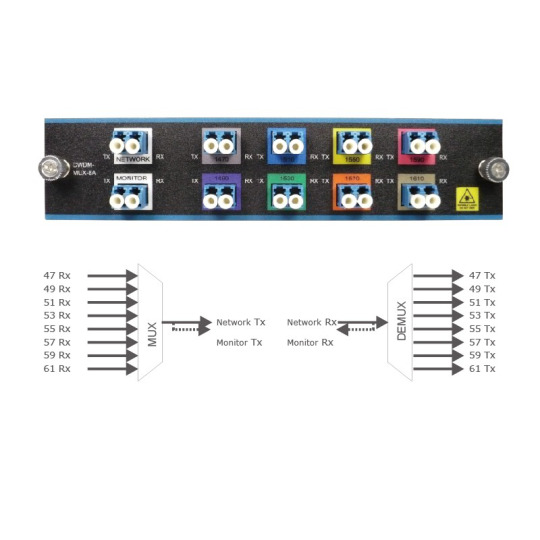
How to Install Your CWDM MUX DEMUX System?
In short, there are four major steps for a CWDM MUX DEMUX system installaltion:
1. Install the Rack-Mount Chassis
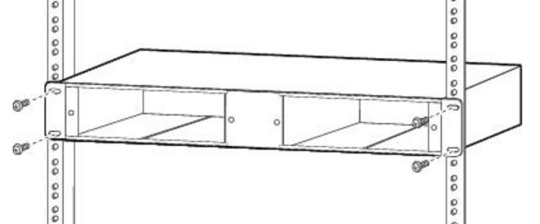
2. Install the CWDM MUX DEMUX Modules
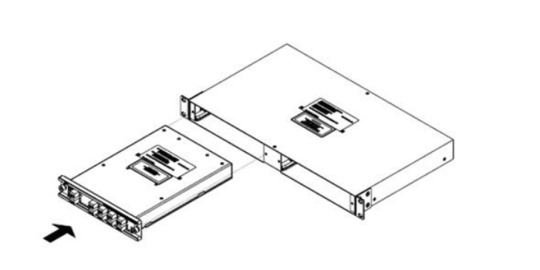
3. Connect the CWDM MUX DEMUX to Switch
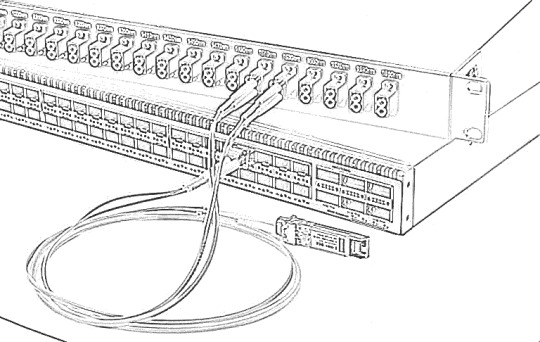
4. Connect the CWDM MUX DEMUX Pairs
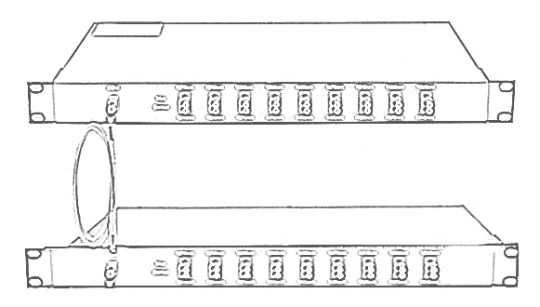
How to Select Fiber Optic Transceiver for Single Fiber CWDM MUX and DEMUX
Because of there has two different wavelengths on a duplex channel port, it could be confused when we need to select a CWDM transceivers for the single fiber CWDM network. So how to select it for single fiber CWDM MUX DEMUX? The Key elements is the wavelength for TX. Still take the above example, on site A 1270nm is used for TX, thus, a 1270nm CWDM transceiver should be used. On site B, a 1290nm CWDM transceiver should be used. The fiber optic transceivers used for single fiber CWDM MUX and DEMUX are different on the two sites.
10Gtek Single Fiber CWDM MUX DEMUX Solution
The products for CWDM network mentioned above are available in 10Gtek. 8 Channels Dual LC CWDM MUX/DEMUX are available and the special ports like pass port can be customized. Any interest, please feel free to contact [email protected] for more information.
The following shows 10Gtek Single Fiber 8 Channels Dual LC CWDM MUX/DEMUX channel port details.
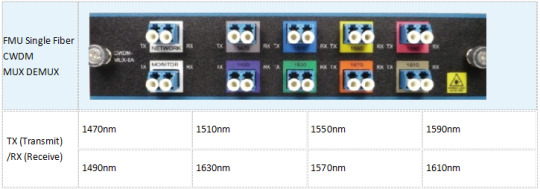
0 notes
Text
Different Ports on WDM Mux/Demux
Different Ports on WDM Mux/Demux
In the WDM (wavelength-division multiplexing) system, CWDM (coarse wavelength-division multiplexing) and DWDM (dense wavelength-division multiplexing) Mux/Demux (multiplexer/demultiplexer) modules are often deployed to join multiple wavelengths onto a single fiber. Multiplexer is for combining signals together, while demultiplexer is for splitting signals apart. On a WDM Mux/Demux, there are many…
View On WordPress
0 notes
Text
Different Ports on WDM Mux/Demux
Different Ports on WDM Mux/Demux
In the WDM (wavelength-division multiplexing) system, CWDM (coarse wavelength-division multiplexing) and DWDM (dense wavelength-division multiplexing) Mux/Demux (multiplexer/demultiplexer) modules are often deployed to join multiple wavelengths onto a single fiber. Multiplexer is for combining signals together, while demultiplexer is for splitting signals apart. On a WDM Mux/Demux, there are many…
View On WordPress
0 notes
Photo

The 4CH CWDM type AWG is widely used in 40G and 100G high-speed active optical modules for optical signal Mux and Demux, such as QSFP+, QSFP28, etc. ALL conforms to RoHS and Telcordia GR-1209-CORE and GR-1221-CORE.Get more from http://www.hyc-system.com/Product/index_209/2173
0 notes
Text
The Arrival of 25G CWDM SFP28
With the ever-increasing demands for faster speed and higher density, SFP transceiver modules have undergone several generations of upgrade for signal speed capability and port density updates, from the original SFP to SFP+ and then to the new SFP28 type. 10GbE has encountered bottlenecks due to the surge in demand for high bandwidth. 25G Ethernet becomes the new standard that provides significant density, cost, and power advantages for server switching links. Today we will come to know the CWDM SFP28 with 25G Gigabit Ethernet.
What Is 25G CWDM SFP28?
CWDM SFP28 transceiver operates on four wavelengths (1270, 1290, 1310, and 1330 nm), which combine to be suitable for 100G in data center networks through course wavelength division multiplexing (CWDM). It is an enhanced version of SFP+ designed for 25G signal transmission. The maximum reach is 10 kilometers. The physical structure of the SFP28 is the same as the popular SFP module and SFP+ module, but the electrical interface is upgraded to 25Gbps per channel. The optical connection of CWDM SFP28 is duplex LC fiber patch cables, and the CWDM SFP28 shall be backward compatible with the traditional 10G SFP + pluggable. 25G CWDM SFP28 is a dual directional device with a transmitter, a receiver and a control management interface (2-wire interface) in the same physical package. The 2-wire interface is used for serial ID, digital diagnostics and module control functions. This module provides very high functionality and integration and is accessible via a two-wire serial interface.

What Is the Difference Between CWDM SFP28 and CWDM SFP+?
We know that SFP+ is made to operate at 10Gb/s. SFP28 uses the same common form factor as SFP+, but the electrical interface is upgraded to 25Gbps per channel. CWDM SFP+ transceiver often operates at a nominal wavelength of CWDM wavelength. To be specific, CWDM SFP+ transceiver can support 18 wavelengths from 1270nm to 1610nm, and its transmission distance is from 20km to 80km. While CWDM SFP28 has four main wavelengths of 1270nm, 1290nm, 1310nm, and 1330nm. And its maximum transmission distance is 10km. Compared to SFP+ solutions, SFP28 has higher bandwidth, superior impedance control, and less crosstalk. A report once said the price of per unit of 10G bandwidth for 25G server Ethernet adapters is much lower. 25G SFP28 provides 2.5 times the bandwidth, but the price is not 2.5 times. All in all, the main advantages of SFP28 over SFP+ can be summarized into two points: lower cost and higher bandwidth.
Advantages of Using 25G CWDM SFP28
Compared to 4G, the spectrum bandwidth used by 5G has increased rapidly. 4G uses a maximum spectrum bandwidth of 20MHz, while 5G low-frequency band uses 100MHz bandwidth, and 5G high-frequency band (millimeter wave) uses 800MHz bandwidth with an upper limit of 1GHz. At present, there is still some difficulty in data processing and transmission of 5G high-frequency band (millimeter wave) and large bandwidth. Considering the smooth evolution of 5G equipment and the development of the industry chain, 25G CWDM SFP28 solution can well solve the current 5G millimeter wave pre-transmission problem. In this case, one 100G QSFP28 optical module is used on the antenna side and four 25G CWDM SFP28 optical modules are used on the baseband side. The construction of a 5G millimeter wave pre-transmission bearer network can be completed with only one MUX/DeMUX bridge connection. There is no need for devices to add an additional shunt function to perform rate matching on both ends. In all, 25G CWDM SFP28 can cost-effectively upgrade network bandwidth to support next-generation 50G (2x25G ), 100G (4X25G) and storage solutions for cloud and web-scale data center environments.
Conclusion
SFP28 assembly solution supports a new generation of high-density 25G Ethernet switches that facilitate server connectivity in data centers and provide a cost-effective upgrade path for enterprises deploying 10G Ethernet links in the future. If you are considering to build a 25 Gigabit Ethernet network, you can visit FS.COM, which offers a variety of CWDM SFP28 with famous compatible brands.
Original Source:
http://www.fiber-optical-networking.com/arrival-25g-cwdm-sfp28.html
0 notes
Photo

www.10giga.com.cn,With the evolution of #5G,Ilot ,higher baud-rate #optical,#cable,#cwdm,#wdm,#200awg,#mpo,#mtp rise tremendously in popularity based on higher density cell sites,in the future,#CWD #Optci,#mux,#demuX Module will be the preferred option in #5G deployment,[email protected]
0 notes
Text
CWDM and DWDM Comparison: What’s the Difference?
DWDM (Dense Wavelength Division Multiplexing) is undoubtedly the popular technology in today's optical fiber applications. However, because of its expensive price, many operators without enough money are quite hesitated to use it. Can we use wavelength division multiplexing at a lower cost? Faced with this demand, CWDM (Coarse Wavelength Division Multiplexing) came into being. And in the post, we will take an introduction on the main difference between CWDM and DWDM and which one is your better choice.
CWDM, as the name suggests, is a DWDM close relative. When comparing CWDM vs. DWDM, their differences are mainly two points as follows:
1. CWDM carrier channel spacing is wide, so the same fiber can only reuse 5 to 6 or so wavelength. This is why we call “Dense” and “Coarse”.
2. CWDM modulates laser by using non-cooling laser, but DWDM is used to cooling laser. The cooled laser is thermally tuned and the non-cooled laser is electronically tuned. Since the temperature distribution is very uneven in a wide wavelength range, the temperature tuning is difficult and costly to achieve. CWDM avoids this difficulty, therefore the cost is significantly reduced, the entire cost of CWDM system is only 30% of DWDM.
CWDM provides very high access bandwidth for low cost, and is suitable for popular network structures such as point-to-point, Ethernet, SONET ring, especially for short distance, high bandwidth, and point-intensive communication applications. Building communication between buildings or buildings. In particular, it is worth mentioning that CWDM and PON (passive optical network) with the use. PON is an inexpensive, point-to-multipoint optical fiber communication method. By combining with CWDM, each individual wavelength channel can be used as the virtual optical link of PON to realize the broadband data transmission between the central node and multiple distributed nodes.
At present, several companies are introducing CWDM-related products. Here we mainly introduce CWDM Mux/Demux and DWDM Mux/Demux.
(1). CWDM Mux/Demux Module:
CWDM Mux and CWDM Demux are designed to multiplex multiple CWDM channels into one or two fibers. The core of CWDM Module application is the passive MUX DEMUX unit. The common configuration is 1×4, 1×8, 1×16 channels. Available in 19″ Rack Mount or LGX module package, optional wide band port is available to multiplex with CWDM Channels wavelength.
(2). DWDM Mux/Demux Module:
DWDM Mux and DWDM DeMux are designed to multiplex multiple DWDM channels into one or two fibers. The common configuration is 4, 8, 16 and 40 channels. These modules passively multiplex the optical signal outputs from 4 or more electronic devices, send them over a single optical fiber and then de-multiplex the signals into separate, distinct signals for input into electronic devices at the other end of the fiber optic link.
However, CWDM is the product of cost and performance compromise; inevitably there are some limitations on performance. Industry experts pointed out that CWDM currently exist below the following four points: First, CWDM in a single fiber to support the number of multiplex wavelengths less, resulting in higher cost of expansion in the future; second, multiplexers, multiplexers, etc. The cost of the equipment should be further reduced, these devices can not only DWDM corresponding equipment, a simple modification; Third, CWDM does not apply to metropolitan area networks, metro nodes between the shorter distance, operators in the CWDM equipment expansion on the money can Used to lay more fiber optic cable, get better results; Fourth, CWDM has not yet formed a standard.
From the CWDM and DWDM comparison above, we can know both the benefits and drawbacks of CWDM and DWDM. If the transmission distance is short and cost is low, then CWDM may be your first choice. On the contrary, you can consider DWDM. For more information about CWDM and DWDM, you can visit: Gigalight.
0 notes